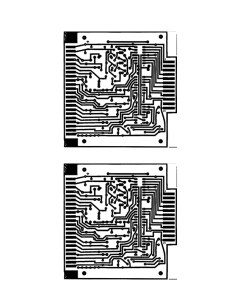With Don Lancaster’s first, primitive ASCII encoder built, it was only natural that I wanted to test it out. Wiring up the keyboard is going to be an eye-crossing affair, and before I start going down the rabbit hole of ‘Why isn’t it generating the proper character?’ with that attached, it’d pay to make sure the encoder is working correctly on its own.
Thanks to my online friend Chuck, it was suggested that I could power the thing, which expected a 10V power supply (or 12V if you changed a diode, and that is what will end up happening as the TVT power supplies 12V), with either a 9V battery or 9V supply. 9V would be just enough to give the thing some life.
Excitedly I soldered in leads for positive and ground, and then used one of those cheapo Radio Shack multi adapters, with no head on. After figuring out which pin socket was positive and negative, I hooked up!
Now what we have to do is simulate keypresses. I’ll try to explain this as best I can within the limits of my own understanding. Take a look at this page from the ASCII encoder article here:
Looking at the table in the bottom left corner, as an example, the comma (,) – the ASCII code for comma is 010-1100. You read from bit 7 down to bit 1 (most significant to least). I don’t know why. Don’t ask. 🙂
Anyway, for our purposes, to generate the desired comma keypress, we need to look at the parts placement guide in the upper right of that same page. Now, this thing isn’t well marked, but essentially comma belongs to a group of symbol keys. You’d have to understand how to read a schematic to figure that out in this case, but I had help. The first pin we need to short for comma is the pin marked /,?.
Now the second bit is tricky and I’ll admit, I have no idea why it’s done this way. But essentially if you look at the lower pins for the larger connector on that parts placement guide, you’ll see they are all three digit combinations of 1s and 0s. Those correspond to the last three bits of the binary code. In the comma’s case, that is 100. So what that means is, to generate a comma, our keyboard matrix must be set up in a way that one side of the comma key contacts the /,? pin of the encoder, and the other contacts the pin marked 100. Since my keyboard isn’t ready yet, I’m just going to use a short piece of wire and.. er.. short those two pins. Then I’m going to use a logic probe to detect how the bits are set with comma pressed:
Voila!
To orient yourself, I am moving my logic probe from pin 1 down through pin 7. Since low on the logic probe is 0, and high is 1, that produces: 0011010 or reversed: 010-1100. Exactly what we expected!
Now truthfully, the video above was taken after some major tweaking. I made some serious rookie mistakes, including accidentally installing 2N5139 transistors where the 2N5129 should be. They are not the same! Luckily I didn’t blow anything up. Once I got that booboo fixed, it was really just a matter of nailing down some accidental solder bridges.
The last hangup was a diode at D13. This is a Class A example of some of the difficulties faced by hobbyists: errors! Looking at the parts placement diagram from the article above, you’d think D13 belongs right between X-Z and H-0 on the far right side of the encoder. WRONG. It’s supposed to be right between D25 and D20. You can even see the pad for it. Ugggggh. This kind of thing fills the inexperienced hobbyist with dread, because this is actually a very simple device. The TVT is not. I do have the advantage of having a full page of corrections included in the instructions I’m working from, so there’s that, but who knows what else was missed! A good rule of thumb: when in doubt, check the schematic! Unless that’s wrong too. Or.. you can’t read a schematic..






































